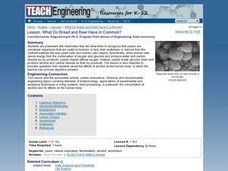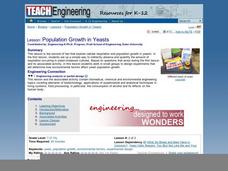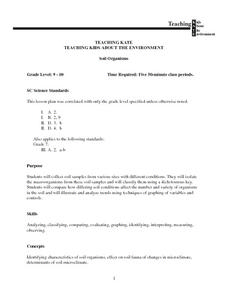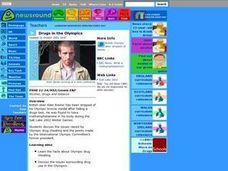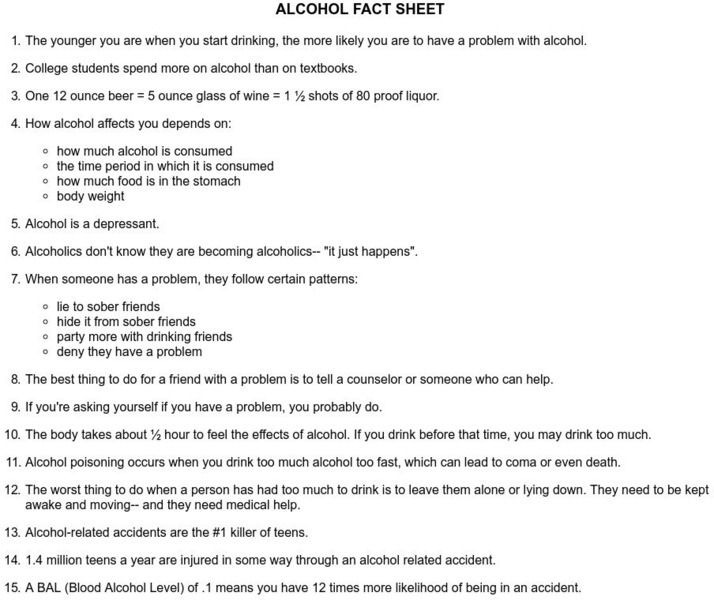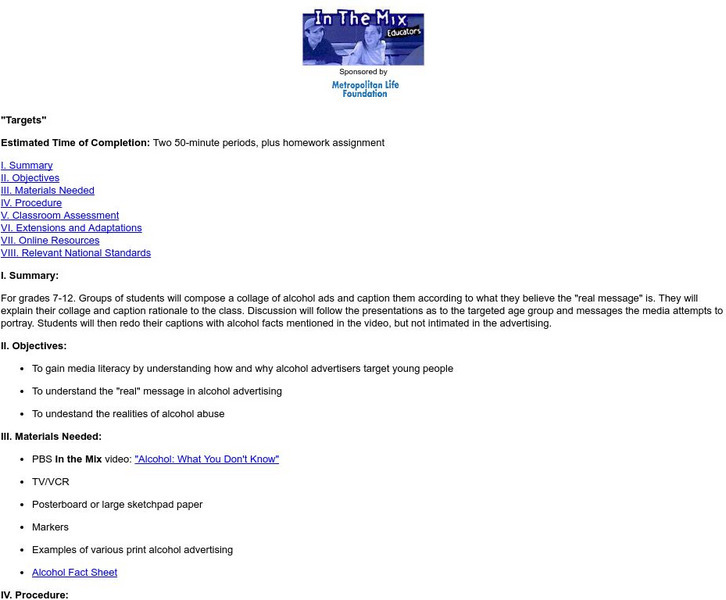Curated OER
A Drink Is a Drink, but People Are Different
Students observe demonstrations that illustrate the amount of alcohol in various drinks and how it is distributed in the body. They discover the effects of alcohol on the brain due to its high water content. They calculate alcohol...
Curated OER
Science: Comparing Beer and Bread
Students compare and contrast cellular respiration in yeast and plant and animal cells. After discovering the role of yeast in making beer and bread, they describe the short and long term effects of alcohol on the nervous and digestive...
Curated OER
Science In Society
Fifth graders study diseases that are related to the use of alcohol, tobacco, and drugs, both prescription and illegal. They determine illnesses that can occur as a direct result of the use of or inappropriate use of these substances....
Curated OER
Anti-drug Shock Tactics
Students evaluate the effectiveness of 'shock tactics' to discourage drug abuse. They view a video about the death of a 21-year-old heroin addict. In small groups they discuss the video and complete comment sheet.
Curated OER
Caffeine and Nicotine
High schoolers research the effects of caffeine and nicotine online.
Curated OER
Population Growth in Yeasts
Students design an investigation using yeast. In this environmental engineering lesson, students design an investigation to determine how environmental factors affect the growth of yeast. They will collect quantitative data and discuss...
Curated OER
Human Embryology
Ninth graders are introduced to the concept of human embryology. Individually, they complete an exercise in which they determine which trait they got from which family member. In groups, they identify and label the reproductive organs...
Curated OER
Soil Organisms
Young scholars work together to collect soil samples from different locations. In the samples, they identify the macroorganisms and classify them. They identify the conditions that affect how macroorganisms grow. They also analyze and...
Curated OER
Drugs In The Olympics
Students brainstorm and discuss the issues raised by Olympic drug cheating from history as well as today. They bring in examples of individuals who have been accused of drug cheating and examine their situations. In addition, they chart...
National Institutes of Health
Alcohol: Separating Fact From Fiction
Students can use this site to observe the effects of alcohol on mice and discuss the ways in which alcohol harms and impairs the body. An online lesson, "Alcohol; Separating Fact From Fiction," has students watch video clips, engage in...
PBS
Pbs: Alcohol Fact Sheet
Here are over twenty facts about alcohol! Topics include alcohol's effect on your body, your brain, and your behavior, and facts about alcohol-related accidents and blood alcohol level (BAL).
Other
Yahoo! Health: Alcohol Abuse
This article from Yahoo! Health briefly defines "alcohol use" and describes the physical and mental effects alcohol has on the body. Read brief write-ups on the history of alcohol use and on underage drinking. Click on hyperlinked...
Mayo Clinic
Mayo Clinic: Alcoholism
This Mayo Clinic site explores what alcoholism is, what it does to the body, and how it can be treated. Content includes information on seeking medical advice, coping skills, and more.
PBS
Pbs: In the Mix Educators: Alcohol "Targets" Lesson Plan
Here is a simple guideline for a two-period lesson through which students "Compose a collage of alcohol ads," and participate in activities that will help hone their critical thinking skills and their views about alcohol and alcohol...
Rice University
Rice University: N Squad: Alcohol and Body Systems
Three problem-solving detective games involve players in investigations of the effect of alcohol on the body's digestive, circulatory, and nervous systems.
Other
Partnership for a Drug Free America: Drug Guide
A comprehensive, current source of drug information, including drug descriptions, slang terms, effects on the body, pictures, and federal classifications for over 40 commonly abused drugs.
TeachEngineering
Teach Engineering: What Do Bread and Beer Have in Common?
Learners are presented with information that will allow them to recognize that yeasts are unicellular organisms that are useful to humans. In fact, their usefulness is derived from the contrast between the way yeast cells and human cells...
TeachEngineering
Teach Engineering: Cellular Respiration and Population Growth
Two lessons and their associated activities explore cellular respiration and population growth in yeasts. Yeast cells are readily obtained and behave predictably, so they are very appropriate to use in middle school classrooms. In the...



